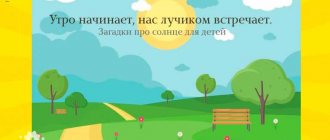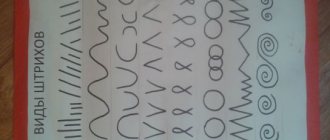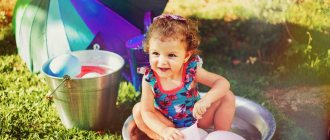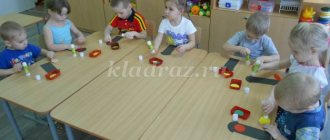Abstract of the GCD “The sun is a source of heat and light”
Children remember that in summer it is necessary to wear hats, sunglasses, and light-colored clothes, because... white color reflects the sun's rays
.
Educator:
Why don’t other stars warm our planet like this?
— The stars are very far away and their light and heat do not reach the Earth. The Earth orbits the Sun. But this is not the only planet with which the Sun is “friends”. There are 8 more.
The sun is at the center of the solar system. Planets move around it. Each planet has its own orbit (path of movement). Planets never collide with each other. The Solar System includes nine planets: Mercury, Venus, Earth, Mars, Jupiter, Saturn, Uranus, Neptune, Pluto. The planets and the Sun resemble a friendly family.
— Since ancient times, people have worshiped the Sun. They decorated dishes, napkins, clothes with solar patterns, and composed proverbs, riddles, and chants. Holidays were held in his honor. In Rus', people celebrated Maslenitsa, and to this day we honor this tradition. People bake pancakes to represent the sun.
Physical education minute.
Smiles in the sky, illuminates everything around (children stand straight, arms extended upward, fingers clench and unclench, showing rays).
In the evening he goes to rest, in the morning he’s right there again (straight arms are lowered down and raised up in a circle, like the hands of a dial).
Educator:
Guys, is it possible to catch a ray of sunshine?
You can’t catch a ray of sunshine with two hands, you can’t slam it with your palm. It is not given to anyone
Now I will tell you one story - a legend:
It was a long time ago. The warships of the mighty state of the ancient Romans sailed across the Mediterranean Sea to the island of Sicily. They approached the white stone walls of Syracuse, the capital of Sicily. The city was surrounded. The townspeople fought bravely, but the forces were not equal. Fewer and fewer defenders remained on the city walls. And then the military leaders turned to their famous fellow countryman, the great scientist Archimedes, and said: “Oh, wise one, now only you can save the city. Come up with an amazing machine to help us in the battle." And Archimedes answered, “Let the wives and sisters of the fallen warriors take their copper-forged shields and bring them to the walls. But first the shields must be polished to a mirror shine.” The military leaders were surprised at the sage’s quirk, but meekly announced his will to the townspeople.
And at the appointed hour, hundreds of women with sparkling shields gathered. Archimedes led them to the wall and formed a crescent. Then the scientist pointed to the nearest Roman ship and ordered each one to shoot a sunbeam at it with a shield. Hundreds of dazzling sunbeams seemed to glare into the ship, and soon its black wooden sides began to smoke. Then a flame appeared, and a few minutes later a huge fire was already burning in the sea. “Now point to another ship!” Archimedes commanded. After some time, the soldiers and sailors of this ship rushed about the deck with screams. Then the third fire began to smoke, the fourth, the fifth. Those ships that were not overtaken by the fiery rays raised their anchors and tried to escape into the open sea. The mighty fleet of the ancient Romans was destroyed, and for a long time the waves washed the charred debris to the shore. So says the legend. For centuries, people considered it a fiction.
Topic: “Visiting the Sun” (01.06-02.06)
Conversations “The Magical World of Theatre”, “How to Behave in the Theatre”.Target
: give children an idea of the theater; expand knowledge of theater as an art form; introduce types of theaters; cultivate an emotionally positive attitude towards the theater; remind you of the rules of behavior in the theater.
Watch a theatrical performance at a local puppet theater.
Plot-role-playing game “We came to the theater.”
Target:
introduce the rules of behavior in the theater; arouse interest and desire to play (play the role of “cashier”, “ticketer”, “spectator”, “actor”); cultivate friendly relationships.
Dramatization game “Come up with a funny and sad dialogue between Mouse and Teddy Bear.”
Target:
develop communication skills; diversify intonation expressiveness.
Game “We won’t tell you what we did”
Target:
develop resourcefulness and imagination.
Productive activity: collective application “Someone lives in a little house.”
Target:
improve the ability to use scissors, develop fine motor skills of the fingers.
Listening to the audio tale “The Wolf and the Seven Little Goats.”
Theatrical performance for kids “The Wolf and the Little Goats”.
Target:
develop artistry and the ability to speak in public.
Sky observation.
Goal: to introduce children to various natural phenomena. Teach to note the state of the sky /clear, cloudy, cloudy/. Activate the words: clouds, clouds.
Bird watching.
Goal: to consolidate children’s knowledge about the habits of birds and their appearance. Create a desire to care for birds.
Tree watching.
Goal: to consolidate knowledge about various deciduous and coniferous trees. Cultivate a caring attitude towards plants.
Labor assignment : collect pebbles in baskets.
Goal: to teach children to perform basic work tasks.
Labor assignment : collect toys after a walk in the basket.
Goal: to teach children to perform simple work tasks.
Wellness exercises after sleep: self-massage
P/n: “Shaggy Dog.” Goal: to strengthen children’s ability to listen carefully to the text, pronounce it together with the teacher. Start moving after the last words.
D/i : “Find a pair.” Goal: classify objects by color/shape/.
D/i : “Magic bag”. Purpose: to strengthen children’s ability to distinguish objects by touch and name them.
P/n : “Sunshine and rain.” Purpose: to train children to disperse, to quickly respond to a signal.
P/n : “Airplanes.” Purpose: to practice running in all directions, without bumping into each other, to respond to a signal.
Round dance game : “Mice dance in a round dance.” Purpose: to practice performing various movements.
Table theater “The Three Little Pigs”, “Little Red Riding Hood” - goal: to cultivate an emotionally positive attitude towards the theater.
Summary of a conversation with parents “The sun is good, the sun is bad!”
Consultation for parents on the topic:
“The sun is good, the sun is bad!”
Target:
Informing parents on this topic.
Tasks:
Inform about the rules for children’s exposure to the sun;
Expand parents' knowledge about the effects of sun rays on children's bodies.
With the onset of hot summer days, everyone is in a hurry to spend more time outdoors. The sun has a beneficial effect on children's bodies. Under the influence of sunlight, vitamin D is produced, which is so necessary for the prevention of rickets, the immune and nervous system is strengthened, metabolism is normalized, and serotonin is produced, which is called the “hormone of joy.” But the sun can become not only your child’s friend, but also his worst enemy. We advise you to strictly follow the rules for keeping children in the sun.
Choice of clothes
Wearing the right clothing will help protect your baby from overheating. Natural cotton and linen will cope best with this. The clothes you dress your child should be light, the cut of the clothes should be loose enough so as not to interfere with breathing and movements. If you are planning long walks, be sure to take long sleeves with you to protect your baby from sun rays (burns).
Sunburn is a burn that occurs as a result of exposure of the skin to ultraviolet rays. The symptoms of a sunburn are the same as those of a burn from a hot object, ranging from redness to blisters. Only they do not appear immediately, but after a few hours - which is why they are dangerous.
Sunburn in a child, first aid
1. Move your child into the shade.
2. Be sure to call an ambulance or consult a doctor yourself if the following phenomena occur:
chills, fever up to 38.5°C and above;
headache;
swelling on the face and hands;
blistering of the skin (i.e., second-degree burn);
first degree burn (redness affecting a large surface of the body;
presence of signs of infection (severe redness of the skin, swelling, pus);
nausea, vomiting, lethargy;
loss of consciousness.
3. Before the ambulance arrives (or in case of a minor sunburn, when the child is not seriously injured), take the following measures:
To relieve pain, moisten or irrigate the affected area of skin with cool water (as it evaporates, it will cool the skin); Place a towel soaked in cool water on the child's shoulders or wrap him in a damp towel for 10-15 minutes. You can repeat this procedure several times with an interval of 30 minutes, just do not overcool the child.
Treat your skin with cosmetics intended for use after sunbathing or medicinal aerosols against burns, if you have them on hand.
2) Headdress
On sunny days in summer, be sure to wear a hat for your child! This can be a light Panama hat or a cotton scarf; a straw hat will also do. This will protect both your head and eyes from the harmful effects of sunlight. The main thing is that the scalp breathes freely.
Monitor your sun exposure
The best time for sunbathing is from 8.00 to 11.00 in the morning and after 16.00 in the evening. Gradually increase your time in the sun. Start with 5 minutes, daily increase the duration of solar treatments by 3 minutes, bring it up to 30 minutes a day.
Doctors consider air temperatures above 30 degrees to be a contraindication to sunbathing.
Symptoms of overheating in the sun
Symptoms of a child overheating in the sun often resemble the symptoms of the onset of an inflammatory disease: the child becomes lethargic (or, conversely, very excited, shakes his head from side to side or throws it back (as with a headache), his body temperature rises. In children or “reactive In children, the only signs of overheating can be psychomotor agitation and a sudden rise in body temperature.
In any case, if you suspect sunstroke or heatstroke, move your child to a cool, shaded area.
Help for heat stroke is simple, but must be provided in a timely manner. If possible, of course it is better to call an ambulance. But even before the ambulance arrives, you must help the child cope with overheating.
1. First of all, move the child to a cool room.
2. Give a horizontal position.
3. Completely undress the child.
4. The child must be cooled as soon as possible. The most effective way is water cooling.
5. The next important step is to give the child enough cool liquid to drink.
Drinking regime
It is very important to monitor your child’s drinking regime. After all, water is the most important component of the body. Offer your baby something to drink more often. It is best to use boiled or bottled water without gas. You can offer an unsweetened rosehip decoction or compote, but any drink must be warm. Let children drink as much as they require. The daily drinking water requirement for a child aged three to seven years is approximately 1.2–1.7 liters.
Love your children and remember that everything is healthy in moderation!





